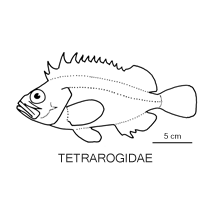- Classification
- ACTINOPTERYGII
- SCORPAENIFORMES
- TETRAROGIDAE
Family TETRAROGIDAE
Well-camouflaged ambush predators with a large movable spine under each eye that can be projected outwards.
Like all scorpaeniform fishes, these bottom-dwelling fishes have well-developed venom glands associated with the sharp spines on the head and fins. They should be handled very carefully, as the wounds inflicted by their spines are extremely painful and potentially dangerous.
More Info
|
Family Taxonomy |
The family Tetrarogidae, previously included as a subfamily of the Scorpaenidae, comprises 16 genera and about 40 species In Australia, 13 genera and 15 described species are known. |
|
Family Distribution |
Widespread in the tropical and temperate Indo-west Pacific, and in the south-eastern Atlantic off southern Africa; found in a variety of coastal marine and estuarine habitats. The Bullrout, Notesthes robusta, is usually confined to fresh water. |
|
Family Description |
The family is defined by a number of internal characters, including the lack of a narrow sensory canal between the pterotic and preopercular bones, the anterior dorsal proximal pterygiophores are sutured to the neurocranium, and the lack of a supracarinalis anterior. The lacrimal bone (infraorbital 1) is highly mobile, hinged to the lateral ethmoid dorsally and abutting but not firmly bound to the first suborbital bone (infraorbital 2) posteriorly. The ventral-most pectoral-fin rays are not detached or separated from the more dorsal pectoral-fin rays; second suborbital bone (third infraorbital) is notably longer than deep, not covering the entire cheek, and usually not forming a wide connection to the preopercle. The skin at the gill openings is connected to each other or not broadly connected to isthmus. |
|
Family Size |
Although one species grows to about 81 cm in length, most are relatively small and less than 15 cm in length. |
|
Family Colour |
Well-camouflaged fishes, usually with mottled colour patterns. |
|
Family Feeding |
Well-camouflaged ambush predators that feed mostly on other fishes and crustaceans. |
|
Family Reproduction |
Oviparous, sexes separate. Eggs and larvae are planktonic. |
|
Family Commercial |
Some species are of minor commerical interest. |
|
Family Remarks |
Tetrarogidae: Greek, tetra = four + Greek, rogos = wrinkled |
|
Author |
Dianne J. Bray |
References
Allen, G.R., D.F. Hoese, N.J. Cross & D.J. Bray. 2006. Family Tetrarogidae. In Hoese, D.F., D.J. Bray, G.R. Allen, J.R. Paxton, P.L. Beesley & A. Wells. Zoological Catalogue of Australia. Volume 35. Fishes. CSIRO Publishing & ABRS. 3 volumes.
Grant, C. 1972. The biology of the soldier fish, Gymnapistes marmoratus (Pisces, Scorpaenidae). Aust. J. Mar. Freshwat. Res. 23(2):151-163.
Ishida, M. 1994. Phylogeny of the suborder Scorpaenoidei (Pisces: Scorpaeniformes). Bulletin of Nansei National Fisheries Research Institute 27: 1–112.
Leis, J.M. & D.S. Rennis. 2000. Scorpaenidae (Scorpionfishes, Stonefishes). Pp. 226–235. In Leis, J.M. & B.M. Carson-Ewart (eds). The Larvae of Indo-Pacific Coastal Fishes: An identification guide.
Motomura, H., P.R. Last & J.W. Johnson. 2008. Review of the waspfish genus Liocranium (Scorpaeniformes: Tetrarogidae), with restoration of L. pleurostigma (Weber). Zootaxa 1820: 27–40.
Nelson, J.S. 2006. Fishes of the World. Hoboken, New Jersey : John Wiley & Sons, Inc. 601 pp.
Neira, F.J. & D.M. Furlani. 1998. Scorpaenidae: scorpionfishes. p. 140-149. In F.J. Neira, A.G. Miskiewicz and T. Trnski (eds.) Larvae of temperate Australian fishes: laboratory guide for larval fish identification. University of Western Australia Press. 474 pp.
Poss, S.G. 1999. Scorpaenidae. Scorpionfishes (also, lionfishes, rockfishes, stingfishes, stonefishes, and waspfishes). p. 2291–2352. In K.E. Carpenter & V.H. Niem (eds.) FAO species identification guide for fishery purposes. The living marine resources of the Western Central Pacific. Vol. 4. Bony fishes part 2 (Mugilidae to Carangidae). Rome, FAO. 2069–2790 pp.
Poss, S.G. & W.N. Eschmeyer, 1975 The Indo-West Pacific scorpionfish genus Ocosia Jordan and Starks (Scorpaenidae, Tetraroginae), with description of three new species. Matsya 1: 1–18.
Smith, W.L. & W.C. Wheeler. 2004. Polyphyly of the mail-cheeked fishes (Teleostei: Scorpaeniformes): Evidence from mitochondrial and nuclear sequence data. Molecular Phylogen. Evol. 32: 627–646.
Smith, W.L. & W.C. Wheeler. 2006. Venom evolution widespread in fishes: a phylogenetic road map for the bioprospecting of piscine venoms. J. Hered. 97(3): 206–217.
Whitley, G.P. 1952. Some noteworthy fishes from eastern Australia. Proceedings of the Royal Zoological Society of New South Wales 1950–51: 27–32, figs. 1–5.



















































































